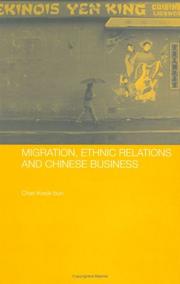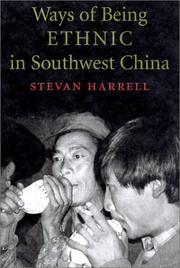| Listing 1 - 6 of 6 |
Sort by
|

ISBN: 113420325X 1280253754 9786610253753 0203029518 9780203029510 0415369274 9781134203208 9781134203246 9781134203253 9780415369275 9780415814218 1134203241 Year: 2005 Publisher: London ; New York : Routledge,
Abstract | Keywords | Export | Availability | Bookmark
 Loading...
Loading...Choose an application
- Reference Manager
- EndNote
- RefWorks (Direct export to RefWorks)
Incorporating research carried out over the last twenty years, this book documents the personal and collective responses of Chinese migrants and refugees to the prejudice and discrimination they have experienced. Using case studies of Chinese communities in Canada, Chan explores the different defence mechanisms Chinese migrants have created in order to escape the systemic and institutionalized discrimination they face. In particular, the book analyzes Chinese entrepreneurship, arguing that it is a collective response to blocked opportunities in host societies. Drawing upon emp
Racism --- Chinese --- Ethnology --- Ethnic identity. --- Canada --- China --- Emigration and immigration. --- S02/0200 --- S11/1100 --- S11/1120 --- S11/1200 --- Ethnic identity --- China: General works--Civilization and culture --- China: Social sciences--Immigration and emigration, Overseas Chinese (huaqiao) --- China: Social sciences--Migration and emigration: U.S.A. and Canada (incl. Hawaï) (whatever timeperiod) --- China: Social sciences--Anthropology, ethnology (incl. human palaeontology): general and China
Book
ISBN: 9888313398 9789888313396 9789888083732 9888083732 Year: 2016 Publisher: Baltimore, Maryland : Baltimore, Md. : Project Muse, Project MUSE,
Abstract | Keywords | Export | Availability | Bookmark
 Loading...
Loading...Choose an application
- Reference Manager
- EndNote
- RefWorks (Direct export to RefWorks)
Tracing China chronicles forty years of fieldwork. The journey began from exploring rural revolution and reconstitutions of community in South China; it spans decades of persistent rural-urban divide and eventually uncovers China's global reach and Hong Kong's cross-border dynamics. Siu traverses both physical and cultural landscapes, examines how political tumults transform into everyday lives, and fathoms the depths of human drama amid China's frenetic momentum toward modernity. She highlights complicity, portraying how villagers, urbanites, cadres, entrepreneurs, and intellectuals--laden with historical baggage--venture forward. The question is: Have they become victims of the circumstances created by their own actions? The essays are woven together by key themes in historical anthropology--culture, history, power, place-making, and identity formation, informed by critical social theories, and characterized by a careful scrutiny of fieldwork encounters and archival texts. Stressing process and contingency, Siu argues that culture and society are constructed through human actions with nuanced meanings, moral imagination, and contested interests. She challenges the perception that social/political changes are merely linear historical progressions. Instead, she traces layers of the past in present realities.
Rural-urban relations --- Ethnology --- Cultural anthropology --- Ethnography --- Races of man --- Social anthropology --- Anthropology --- Human beings --- Rural-urban interaction --- Urban-rural interaction --- Urban-rural relations --- Sociology, Rural --- Sociology, Urban --- Hong Kong (China) --- China, Southeast --- Hong Kong Special Administrative Region (China) --- Xiang gang te bie xing zheng qu (China) --- 香港特別行政區 (China) --- Zhonghua Renmin Gongheguo Xianggang Tebie Xingzhengqu --- Chung-hua jen min kung ho kuo Hsiang-kang tʻe pieh hsing cheng chʻü --- Zhong hua ren min gong he guo Xiang gang te bie xing zheng qu --- 中華人民共和國香港特別行政區 --- HKSAR (China) --- Hsiang-kang tʻe pieh hsing cheng chʻü (China) --- Xianggang (China) --- 香港 (China) --- Xianggang Tebie Xingzhengqu (China) --- Hong Kong S.A.R. (China) --- Hong Kong --- Southeast China --- Civilization. --- S02/0200 --- S03/0620 --- S11/1200 --- China: General works--Civilization and culture --- China: Geography, description and travel--Southern provinces --- China: Social sciences--Anthropology, ethnology (incl. human palaeontology): general and China
Book
ISBN: 9780520295506 9780520295490 9780520967687 0520967682 0520295498 0520295501 Year: 2017 Publisher: Berkeley, CA : University of California Press,
Abstract | Keywords | Export | Availability | Bookmark
 Loading...
Loading...Choose an application
- Reference Manager
- EndNote
- RefWorks (Direct export to RefWorks)
The Great Han is an ethnographic study of the Han Clothing Movement, a neotraditionalist and racial nationalist movement that has emerged in China since 2001. Participants come together both online and in person in cities across China to revitalize their utopian vision of the authentic "Great Han" and corresponding "real China" through pseudotraditional ethnic dress, reinvented Confucian ritual, and anti-foreign sentiment. Analyzing the movement's ideas and practices, this book argues that the vision of a pure, perfectly ordered, ethnically homogeneous, and secure society is in fact a fantasy constructed in response to the challenging realities of the present. Yet this national imaginary is reproduced precisely through its own perpetual elusiveness. The Great Han is a pioneering analysis of Han identity, nationalism, and social movements in a rapidly changing China.
Costume --- Nationalism --- Racism --- Race --- Ethnicity --- Politics and culture --- S02/0200 --- S11/1200 --- Physical anthropology --- Bias, Racial --- Race bias --- Race prejudice --- Racial bias --- Prejudices --- Anti-racism --- Critical race theory --- Race relations --- Consciousness, National --- Identity, National --- National consciousness --- National identity --- International relations --- Patriotism --- Political science --- Autonomy and independence movements --- Internationalism --- Political messianism --- Fancy dress --- Motion pictures --- Opera --- Stage costume --- Theater --- Theatrical costume --- Decorative arts --- Clothing and dress --- Culture --- Culture and politics --- Ethnic identity --- Group identity --- Cultural fusion --- Multiculturalism --- Cultural pluralism --- History --- China: General works--Civilization and culture --- China: Social sciences--Anthropology, ethnology (incl. human palaeontology): general and China --- Political aspects --- Costume. --- Ethnicity. --- Ethnische Identität. --- Nationalism. --- Nationalismus. --- Politics and culture. --- Race. --- Racism. --- Rassismus. --- Soziale Bewegung. --- 2000-2099. --- China. --- 2000s. --- 2001. --- activism. --- anti foreign. --- chinese politics. --- cities. --- confucian ritual. --- digital space. --- digital world. --- ethics. --- ethnic dress. --- ethnographic study. --- ethnographic. --- ethnography. --- foreign sentiment. --- han clothing movement. --- nationalism. --- neotraditionalist. --- online. --- political activism. --- political movement. --- racial nationalist. --- social movements. --- social science. --- social studies. --- urban. --- utopian. --- xenophobic.

ISBN: 0295981229 0295981237 0295804076 9780295804071 9780295981222 9780295981239 Year: 2014 Publisher: Vancouver : University of Washington Press,
Abstract | Keywords | Export | Availability | Bookmark
 Loading...
Loading...Choose an application
- Reference Manager
- EndNote
- RefWorks (Direct export to RefWorks)
Drawing on extensive fieldwork conducted in the 1980s and 1990s in southern Sichuan, this pathbreaking study examines the nature of ethnic consciousness and ethnic relations among local communities, focusing on the Nuosu (classified as Yi by the Chinese government), Prmi, Naze, and Han. It argues that even within the same regional social system, ethnic identity is formulated, perceived, and promoted differently by different communities at different times.Ways of Being Ethnic in Southwest China exemplifies a model in which ethnic consciousness and ethnic relations consist of drawing boundaries between one�s own group and others, crossing those boundaries, and promoting internal unity within a group. Leaders and members of ethnic groups use commonalties and differences in history, culture, and kinship to promote internal unity and to strengthen or cross external boundaries. Superimposed on the structure of competing and cooperating local groups is a state system of ethnic classification and administration; members and leaders of local groups incorporate this system into their own ethnic consciousness, co-opting or resisting it situationally.The heart of the book consists of detailed case studies of three Nuosu village communities, along with studies of Prmi and Naze communities, smaller groups such as the Yala and Nasu, and Han Chinese who live in minority areas. These are followed by a synthesis that compares different configurations of ethnic identity in different communities and discusses the implications of these examples for our understanding of ethnicity and for the near future of China. This lively description and analysis of the region�s complex ethnic identities and relationships constitutes an original and important contribution to the study of ethnic identity.Ways of Being Ethnic in Southwest China will be of interest to social scientists concerned with issues of ethnicity and state-building.
Acculturation -- China -- Sichuan Sheng. --- Ethnic groups -- Government policy -- China -- Sichuan Sheng. --- Ethnicity -- China -- Sichuan Sheng. --- Sichuan Sheng (China) -- Ethnic relations. --- Sichuan Sheng (China) -- Social conditions. --- Sichuan Sheng (China) -- Social policy. --- Ethnicity --- Ethnic groups --- Acculturation --- Gender & Ethnic Studies --- Social Sciences --- Ethnic & Race Studies --- Government policy --- Ethnicité --- Groupes ethniques --- Politique gouvernmentale --- Sichuan Sheng (China) --- Sichuan (Chine) --- Ethnic relations. --- Social policy. --- Social conditions. --- Relations ethniques --- Politique sociale --- Conditions sociales --- S03/0612 --- S06/0240 --- S11/1200 --- S11/1215 --- Ethnic identity --- Group identity --- Cultural fusion --- Multiculturalism --- Cultural pluralism --- Ethnic identities --- Ethnic nations (Ethnic groups) --- Groups, Ethnic --- Kindred groups (Ethnic groups) --- Nationalities (Ethnic groups) --- Peoples (Ethnic groups) --- Ethnology --- Culture contact --- Development education --- Civilization --- Culture --- Assimilation (Sociology) --- China: Geography, description and travel--Sichuan --- China: Politics and government--Policy towards minorities and autonomous regions --- China: Social sciences--Anthropology, ethnology (incl. human palaeontology): general and China --- China: Social sciences--Works on national minorities and special groups: since 1949 --- 四川省 (China) --- Ssu-chʻuan sheng (China) --- Sze-chʻuen (China) --- Sze-chuan (China) --- Sychuan (China) --- Shisen-shō, China --- Szechwan Province (China) --- Szetschwan (China) --- Szʻ-chuen (China) --- Szechwen (China) --- Ssuchuan (China) --- Süchwan (China) --- Szechwan, China --- Ssu-chʻuan sheng jen min cheng fu (China) --- Ssu-chʻuan (China) --- Sichuan Province (China) --- Sichuan (China) --- Four Rivers Province (China) --- Szechuen (China) --- Szechuan (China) --- Xikang Sheng (China) --- Culture contact (Acculturation) --- 四川 (China) --- Sri-khron Zhing (China) --- Sri-khron (China) --- Social & cultural anthropology
Book
ISBN: 9780691140315 0691140316 9786613012128 1400838606 128301212X 9781400838608 Year: 2011 Publisher: Princeton Princeton University Press
Abstract | Keywords | Export | Availability | Bookmark
 Loading...
Loading...Choose an application
- Reference Manager
- EndNote
- RefWorks (Direct export to RefWorks)
In their earliest encounters with Asia, Europeans almost uniformly characterized the people of China and Japan as white. This was a means of describing their wealth and sophistication, their willingness to trade with the West, and their presumed capacity to become Christianized. But by the end of the seventeenth century the category of whiteness was reserved for Europeans only. When and how did Asians become "yellow" in the Western imagination? Looking at the history of racial thinking, Becoming Yellow explores the notion of yellowness and shows that this label originated not in early travel texts or objective descriptions, but in the eighteenth- and nineteenth-century scientific discourses on race. From the walls of an ancient Egyptian tomb, which depicted people of varying skin tones including yellow, to the phrase "yellow peril" at the beginning of the twentieth century in Europe and America, Michael Keevak follows the development of perceptions about race and human difference. He indicates that the conceptual relationship between East Asians and yellow skin did not begin in Chinese culture or Western readings of East Asian cultural symbols, but in anthropological and medical records that described variations in skin color. Eighteenth-century taxonomers such as Carl Linnaeus, as well as Victorian scientists and early anthropologists, assigned colors to all racial groups, and once East Asians were lumped with members of the Mongolian race, they began to be considered yellow. Demonstrating how a racial distinction took root in Europe and traveled internationally, Becoming Yellow weaves together multiple narratives to tell the complex history of a problematic term.
Racism --- Race awareness --- East Asians --- National characteristics, East Asian --- History --- Race identity --- National characteristics, East Asian. --- Race identity. --- S11/1200 --- S02/0300 --- S03/0240 --- J4129 --- China: Social sciences--Anthropology, ethnology (incl. human palaeontology): general and China --- China: General works--Chinese culture and the West and vice-versa --- China: Geography, description and travel--Travels: 1500-1840 --- Japan: Sociology and anthropology -- cross-cultural contacts, contrasts and globalization --- Bias, Racial --- Race bias --- Race prejudice --- Racial bias --- East Asian national characteristics --- Prejudices --- Anti-racism --- Race relations --- Awareness --- Ethnopsychology --- Ethnic attitudes --- Asians --- Ethnology --- Sociology of minorities --- History of Asia --- anno 1700-1799 --- anno 1800-1899 --- Critical race theory --- Carl Linnaeus. --- China. --- Chinese. --- Down syndrome. --- East Asian bodies. --- East Asians. --- Far East. --- Franois Bernier. --- Japan. --- Japanese. --- Johann Friedrich Blumenbach. --- Mongolian bodies. --- Mongolian eye. --- Mongolian race. --- Mongolian spot. --- Mongolian. --- Mongolianness. --- Mongolism. --- Sino-Japanese War. --- Tartar. --- Tom Pires. --- Wilhelm II. --- anatomical quantification. --- anthropology. --- color top. --- homo sapiens. --- human taxonomies. --- medicine. --- merchants. --- missionaries. --- race. --- racial thinking. --- racism. --- skin color. --- travel narrators. --- whiteness. --- yellow peril. --- yellow race. --- yellow. --- yellowness. --- Racism - Western countires - History - 18th century --- Racism - Western countires - History - 19th century --- Race awareness - Western countries - History - 18th century --- Race awareness - Western countries - History - 19th century --- East Asians - Race identity

ISBN: 052092794X 9786612759000 159734687X 1282759000 9780520927940 1417508191 9781417508198 9780520231818 0520231813 9780520231825 0520231821 9781597346870 0520231813 0520231821 6612759003 9781282759008 Year: 2004 Publisher: Berkeley : University of California Press,
Abstract | Keywords | Export | Availability | Bookmark
 Loading...
Loading...Choose an application
- Reference Manager
- EndNote
- RefWorks (Direct export to RefWorks)
The "one China" policy officially supported by the People's Republic of China, the United States, and other countries asserts that there is only one China and Taiwan is a part of it. The debate over whether the people of Taiwan are Chinese or independently Taiwanese is, Melissa J. Brown argues, a matter of identity: Han ethnic identity, Chinese national identity, and the relationship of both of these to the new Taiwanese identity forged in the 1990's. In a unique comparison of ethnographic and historical case studies drawn from both Taiwan and China, Brown's book shows how identity is shaped by social experience-not culture and ancestry, as is commonly claimed in political rhetoric.
Tujia (Chinese people) --- Chinese reunification question, 1949 --- -Nationalism --- Nationalism --- Ethnicity --- Taiwan aborigines --- Tʻu-chia (Chinese people) --- Ethnology --- Chinese unification question, 1949 --- -Reunification of China question, 1949 --- -Unification of China question, 1949 --- -Consciousness, National --- Identity, National --- National consciousness --- National identity --- International relations --- Patriotism --- Political science --- Autonomy and independence movements --- Internationalism --- Political messianism --- Ethnic identity --- Group identity --- Cultural fusion --- Multiculturalism --- Cultural pluralism --- Aborigines, Taiwan --- Indigenous peoples --- Taiwan aboriginal peoples --- History --- History. --- Enshi Tujiazu Miaozu Zizhizhou (China) --- China --- Taiwan --- Exi Tujiazu Miaozu Zizhizhou (China) --- Ethnic relations --- Relations --- Autochtones --- Chine, Question de la réunification de la (1949- ). --- Chinese reunification question, 1949-. --- Ethnic relations. --- Ethnicity. --- Ethnicité --- Ethnische Identität. --- Ethnizität. --- Indigenes Volk. --- International relations. --- Nationalbewusstsein. --- Nationalism. --- Nationalisme --- Nationalismus. --- Tujia (Peuple de Chine) --- Identité ethnique --- Histoire --- 1900-1999. --- Geschichte. --- China. --- Chine --- Enshi Tujiazu Miaozu Zizhizhou (Chine) --- Taiwan. --- Relations interethiques --- -Ethnicity --- S02/0200 --- S11/1080 --- S11/1200 --- S26/0515 --- S26/0840 --- Consciousness, National --- -Aborigines, Taiwan --- Ethnic identity&delete& --- China: General works--Civilization and culture --- China: Social sciences--Migration inside China --- China: Social sciences--Anthropology, ethnology (incl. human palaeontology): general and China --- Taiwan--China's claim to Taiwan (and vice-versa) --- Taiwan--Ethnology (aborigines and others) --- -Tujia (Chinese people) --- -Tʻu-chia (Chinese people) --- -History --- 1990s. --- ancestry. --- asia. --- asian history. --- asian identity. --- case study. --- china. --- chinese history. --- chinese identity. --- chinese independence. --- culture. --- ethnic identity. --- ethnicity. --- ethnography. --- identity politics. --- peoples republic of china. --- political rhetoric. --- political. --- race. --- racism. --- taiwan. --- taiwanese history. --- taiwanese identity. --- united states. --- world history.
| Listing 1 - 6 of 6 |
Sort by
|

 Search
Search Feedback
Feedback About
About Help
Help News
News